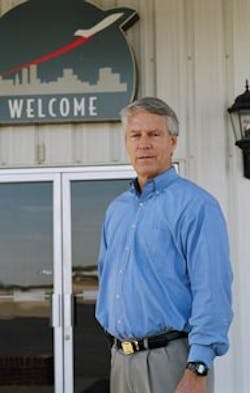A Different Business Model
TULSA — The Jones-Riverside Airport just south of downtown Tulsa is a mix of older private business hangars and some 525 based aircraft, mostly piston, with an adjacent river plain that affords a clear zone that may protect the airport long-term from encroaching suburbs. There is an abundance of training activity, led by a Tulsa Community College complex and the training center for the Spartan College of Aeronautics & Technology. Besides training, another thing the two colleges have in common is they have been customers of Bill Christiansen, who for some 23 years has been leasing single-engine aircraft to flight schools. He also operates a full-service fixed base operation, Christiansen Aviation, which more and more is moving into the jet arena.
In many ways, Bill Christiansen’s story is similar to that of other fixed base operators. He started in flight training in 1972, added fueling, became a Cessna dealer and pilot center, and added leaseholds as his business grew. Today, Christiansen Aviation encompasses six leaseholds, each with 20-year terms, with 89,000 square feet of hangar space, 23,000 square feet of office space, and some 68 based aircraft. Rates and charges are based on square footage and an escalator for CPI (consumer price index). Christiansen says they’re reasonable, with the exception of a ten cent fuel flowage fee.
Jones-Riverside does offer one distinct advantage — it has no reversion clause.
Says Christiansen, “The biggest asset you have is the equity in the hangars. I’m not sure we would have done what we’ve done here if there was a reversion clause.”
Today, the FBO generates more than $10 million in annual revenues, with monthly fuel averaging some 70,000 gallons for jet-A and 25,000 gallons for avgas. But fuel is only number two as a profit center; it’s the aircraft leasing business that accounts for 40 percent of the company’s business, according to Christiansen.
A new idea; good timing
Like many operators, Christiansen saw his business threatened in the early ‘80s when interest rates topped 21 percent. “I got caught owning too many airplanes and not having enough business,” he recalls. “I promised myself that if I ever got out of that mess I’d never let it happen again. It was quite unsettling; I remember selling airplanes just to get rid of them, selling them for less than I owed on them.
“Back then I was big into the flight school business; a VA flight school; a Part 141 flight school. I realized that I needed to be more diversified, to become more active in selling airplanes.”
The opportunity for leasing came from Spartan, which approached the Cessna dealer because it was having difficulty getting aircraft on short notice. “They asked if I could lease them airplanes because they were having a problem getting them when they needed them,” explains Christiansen. We put together a deal where they leased by the hour, and that’s how I got into the leasing business.”
Before long, he got a call from an aircraft dealer who had a potential customer who was attending Auburn University in Alabama. The dealer wanted to sell Christiansen the aircraft and then have the customer at Auburn lease it, which is what transpired.
“Before you know it, they called and wanted to do another one,” says Christiansen. “I decided that was a good business to be in. I still own that original airplane today; it was just painted for probably the fifth time.”
Over the years the leasing program has grown to 265 aircraft at proprietary flight schools and universities nationwide — Auburn; Gateway Technical College; Fox Valley Technical Institute; Sierra Academy; North American Institute of Aviation; Oklahoma State University; among others.
Ironically, while Christiansen provides a dozen single-engine Cessnas for Christiansen Aviation’s flight school, he no longer employs instructors. “I just provide the airplanes and the students get their own instructors,” he explains. “It’s just another way for me to diversify.”
He credits much of the success of the program to the fact that he built much of his leasing fleet in the ‘80s, before shortages hit the used market and before new units began entering the market following liability reform.
“I started back when it was easier to get in the business and made it work for me,” Christiansen says. “Look at a 1981 Cessna 172 that I bought in 1985 for $25,000, with maybe 500 hours on it. Today, that airplane is probably worth $40-45,000, and it’s got 8-9,000 hours on it.
“But now I’m to the point that I’m having to buy newer, almost-new airplanes. I get more money for them per hour, but it’s hard to get a lot more.”
According to Christiansen, the majority of his aircraft leases are by the hour, with a guaranteed minimum (usually 40) hours per month.
He’s expanded his maintenance shop, and has three technicians who solely focus on rebuilding Lycoming engines for his company aircraft. At the same time, he’s moving the department more into turbines as his based customers upgrade to jets.
Admitting the business is tougher today, Christiansen still sees opportunity, particularly because of the increasing dominance of universities and proprietary flight schools.
